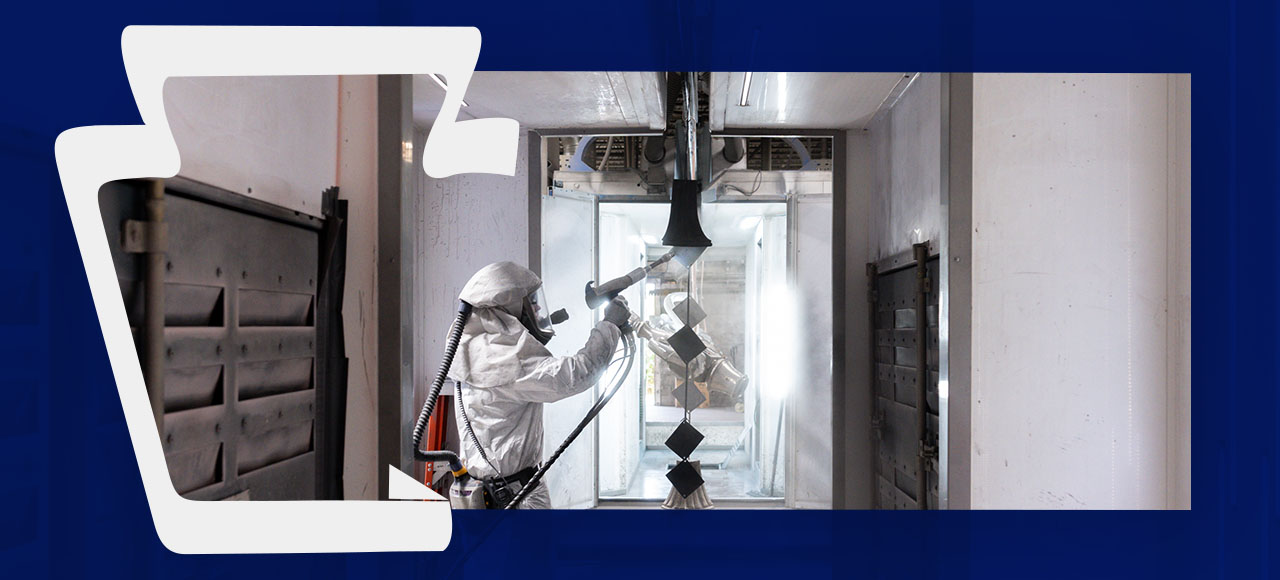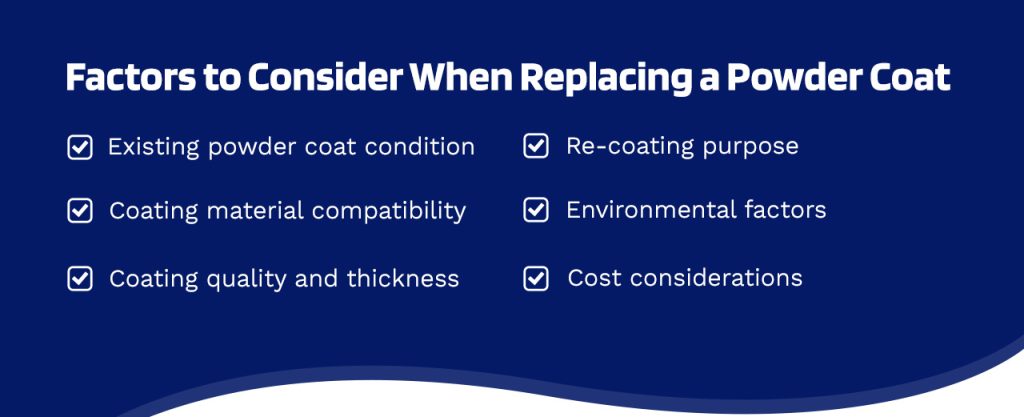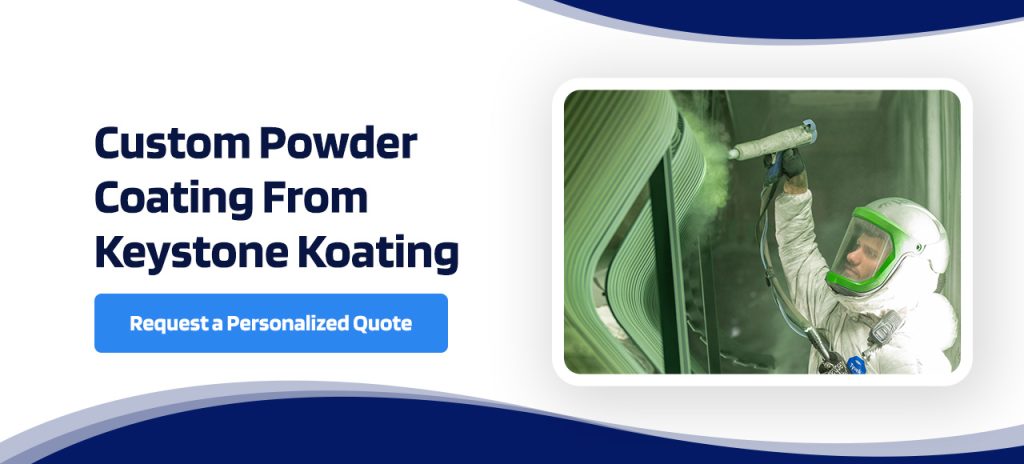
Powder coating delivers vibrant, durable coverage to various objects. After an initial powder coating, equipment may take heavy wear and damage, leading to fading, chipping or a compromised coat. Fortunately, you can get a fresh powder coat with the right professional assistance. Sometimes, it’s more cost-effective to powder coat over powder coat. Understanding powder coating and re-powder coating will help you pick the right option to ensure your materials look good and withstand heavy wear.
What Is Powder Coating?
Powder coating is a popular finishing technique. It involves applying a dry, finely ground material onto a surface. Thanks to its durability, corrosion resistance and environmental advantages, powder coating is preferred for protecting various metals. It is widely used in the automotive, furniture and architecture industries for its resistance to chipping, fading and corrosion.
How is Powder Coating Applied?
Powder coating applies a ground material onto something, usually metal, through an electrostatic process. The powder particles are charged, allowing them to adhere to the grounded surface of the substrate and form a uniform, smooth coating. This coating is melted and cured under heat, creating a durable, protective finish.
Surface Preparation
Surface preparation is an essential part of the powder coating process. Surfaces need thorough cleaning and degreasing. Additionally, surfaces require roughening or treatment to ensure proper powder coating adhesion. Contaminants or residues can lead to adhesion issues and affect the overall coating quality. Proper preparation ensures the powder coating’s longevity and effectiveness.
Can You Powder Coat Over an Existing Powder Coat?
While it’s possible to powder coat over powder coat, removing the old layer creates a stronger, smoother layer. Over time, the existing coat may have suffered wear, damage or color fading.
Removing it allows for a fresh start, ensuring the new coating adheres well to the substrate. It also provides an opportunity to inspect and address any underlying issues like corrosion or surface defects that may have developed beneath the old powder coat.
Powder coating over powder coat can be a viable option in some cases, saving time and resources when the existing coat is still in good condition.
Can You Powder Coat a Different Color Over Powder Coat?
Yes, it is possible to powder coat a different color over an existing powder coat, although stripping the old layer first would create a longer-lasting coat. This process, often referred to as re-powder coating, can be an effective way to update the functionality of worn or outdated items without stripping the original layer.
Can You Powder Coat a Different Coat Over an Existing Coat?
Yes, but this process has limitations, and many considerations are required. Generally, you must ensure the new powder coat is compatible with the existing powder coat. Different powder types may not adhere well to each other. For example, a new polyester powder coat might not adhere well to an existing epoxy powder coat because of chemical structure differences.
If the powder coating you want to use will not be compatible with the existing coating, you will likely have to choose another approach. It is highly recommended to work with a professional to make sure you select the right coat for your project.
Factors to Consider When Replacing a Powder Coat
Several factors need to be considered when deciding whether to powder coat over an existing coat or strip the existing coat first. It is essential to ensure the integrity of the surface by making sure everything beneath the existing coat is in good condition. Improper application, current condition or removal could compromise the surface’s durability.
Before getting a second powder coat, think about these points:
- Existing powder coat condition: The existing powder coat’s condition is critical when determining whether re-coating is advisable. If the old coating is in good condition, defect-free and still adhering well, it could be a candidate for re-coating. However, removal might be the best option if it’s overly damaged, chipped or peeling.
- Coating material compatibility: Ensuring compatibility between the existing powder coat and the new one is essential. Different powder coating types might adhere poorly to each other, which leads to adhesion problems or a compromised finish. Compatibility testing or consulting with a coating expert is recommended to select the right combination.
- Coating quality and thickness: The thickness and quality of the existing and new coating play a significant role. Excessive layering can lead to issues like cracking or reduced adhesion. Maintaining appropriate coating thickness and quality is crucial to achieve your desired performance and appearance.
- Re-coating purpose: Do you want to change the color, improve durability or simply refresh the material’s appearance? Understanding the purpose behind re-coating is essential, as your goals for re-coating may require a different approach.
- Environmental factors: Consider the environment where the coated item will be used. For items exposed to harsh conditions, stripping the old coat and starting fresh might provide better long-term protection.
- Cost considerations: While powder coating over powder coat can be more cost-effective in some cases, it’s essential to weigh this against the potential need for future repairs or re-coating if adhesion issues occur.
Considering these factors will help you make informed decisions about whether you want to powder coat over powder coat or opt for removal and reapplication, ensuring the best results in terms of appearance and performance.
The Process of Powder Coating Over an Existing Coating
If you’re moving ahead with powder coating over an existing layer, you should contact a professional service for assistance. Professional powder coating contractors have the experience and tools to perform the job efficiently and effectively.
Here’s what the professional powder coating process will look like if you have an existing
- Cleaning and degreasing: Before applying a new powder coat over an existing one, the material requires meticulous cleaning. Professionals will remove any surface dirt, dust or contaminants with solvents or appropriate cleaning agents. Degreasing ensures that no oils or residues compromise the new coating’s adhesion.
- Sanding or stripping: Depending on its condition, professionals might need to sand or strip the old coating lightly. Sanding and abrading helps create a rougher surface for better adhesion, while stripping is more extensive and involves removing the old coating entirely. The choice between these methods depends on the coating’s condition and compatibility with the new powder.
- Coating application: After prepping the surface, they’ll apply the new powder using the same electrostatic process as in initial applications. Professionals will ensure even and consistent coverage to achieve a uniform finish. Selecting the right color, material and texture to meet design and functional requirements is essential.
- Curing process: After applying the new powder coat, they’ll transfer the coated item to an oven for curing. The curing process involves heating the coated surface to a specific temperature for a set duration, allowing the powder to melt, flow and bond to the substrate. This step creates a durable and protective finish.
Before committing to powder coat over powder coat for an entire project, ask your contractor to perform a patch test on a small, inconspicuous area. Patch testing allows you to assess the adhesion, color and quality of the new coat on top of the existing one to determine if you would like the finished result.
Potential Challenges and Risks
While applying powder coat over powder coat can be effective, professionals will look out for several potential challenges and risks. They’ll evaluate your item for these issues to ensure it should receive another coat without taking off the existing layer:
- Adhesion issues: One of the primary challenges when powder coating over a current layer is ensuring proper adhesion. If the old coating has degraded or if the surface preparation is inadequate, the new coating may not bond effectively. Improper bonding can result in peeling, chipping or bubbling, compromising the coating’s integrity.
- Coating thickness problems: Layering multiple powder coats can lead to issues with coating thickness. Excessive layers can affect the coating’s appearance and functionality, potentially resulting in uneven surfaces or an overly thick finish. Balancing the desired thickness while avoiding over-application is essential.
- Aesthetics and durability: Re-powder coating over an existing layer might not yield the same level of durability and aesthetics as starting fresh. If the old coating is severely damaged or there are color discrepancies, these may still be visible after re-coating. The overall durability could also be compromised if adhesion or surface issues pop up.
- Cost considerations: Re-powder coating involves additional labor and material costs, including the need for additional thorough surface preparation. While suitable for an array of projects and budgets, an alternative approach may be a better option for some applications.
Alternatives to Re-Coating Over the Existing Powder Coat
If your re-coating job looks like it might not be durable or will cost the same as a fresh coat, there are other options. Consult your professional powder coating contractor for the right option for your materials. Here are two effective alternatives to re-coating:
- Stripping and starting fresh: In cases where the existing coating is severely damaged or incompatible with the new powder, stripping the old powder coating and starting with a clean surface is preferred. This approach ensures a fresh, even and durable finish.
- Repair and touch-up: Instead of a complete re-coating, minor imperfections or damage in the existing powder coat can be repaired through touch-up techniques like painting, though bonding issues may arise. This approach is cost-effective and suitable for localized issues, preserving the original coating’s integrity when possible.
Why Trust Us
At Keystone Koating, we’re more than powder coating experts — we’re pioneers with over three decades of hands-on experience. As the only PCI 3000 certified powder coater in Pennsylvania, we’ve proved our commitment to excellence. Our AAMA 2604-13 verification demonstrates our ability to produce finishes that withstand the harshest conditions. We’ve completed numerous re-powder coating projects, from automotive parts to architectural elements, each presenting unique challenges that have honed our expertise.
Our advanced eight-stage pretreatment system and state-of-the-art facilities in Lititz and Mifflintown, Pennsylvania, allow us to handle high-volume orders with precision and speed. When powder coating over existing layers, our experience with KEYCOAT20, our exclusive 20-year warranty product, showcases our confidence in delivering beautiful, durable finishes. Trust Keystone Koating for insights backed by decades of real-world application and continuous innovation.
Custom Powder Coating From Keystone Koating
If you want to elevate your surfaces’ aesthetics and durability, invest in custom powder coating services from Keystone Koating. Our experienced team specializes in tailor-made powder coating services that suit your unique needs. Whether it’s reviving existing coatings or starting fresh, we’re here to provide expert guidance and deliver exceptional results.
Contact us now for a personalized quote and take the first step towards a vibrant, long-lasting finish for your projects. Your surfaces deserve the Keystone Koating touch.
Updated October 14, 2024. Originally published October 23, 2023.



